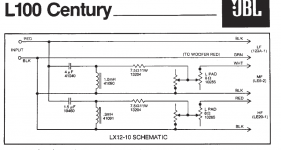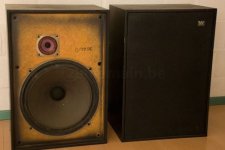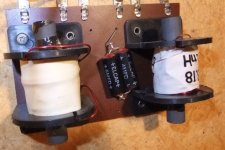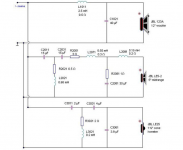Hi, Everyone.
So looking to build my first ever Passive Crossover. I have selected the drivers I am going to use for this application. I have (both Vintage Drivers) two ESS Heil AMT's and two JBL 123A-1 drivers one of each for each loudspeaker.
I'm going to be doing some open baffle tests in the room that will serve as my listening room. In order to understand what type of sound processing and equalization I will need to build crossovers.
I'm new to this so please bear with me.
I found this site:
2-Way Crossover Calculator / Designer
For the parameters I punched in..
Tweeter Impedance: 4
Woofer Impedance: 4.7
Frequency: 1000
Order: 3rd Buttersworth
I get a diagram which looks pretty straight forward. I'll be plugging everything into a bread board first.
Here's my question, do I round up or down? The results are:
Capacitors
C1 = 26.53 uF
C2 = 79.58 uF
C3 = 48.23 uF
Inductors
L1 = 0.48 mH
L2 = 1.05 mH
L3 = 0.35 mH
For you crossover experts, which actual capacitors and conductors do I need?
Also, it's worth mentioning that the the tweeter is about +6db in SPL than the woofer, so I will need to add some kind of additional capacitor I'm guessing at the end of the line on the + of the tweeters. I had to do the same in my car with my Focal K2s and even then it needed DSP correction because it wasn't enough.
Let me know if someone can help me build these damn things! I will be listening to Vinyls with a Hana SL cartridge so I do want good quality electronics here.
Let me know,
Joey
So looking to build my first ever Passive Crossover. I have selected the drivers I am going to use for this application. I have (both Vintage Drivers) two ESS Heil AMT's and two JBL 123A-1 drivers one of each for each loudspeaker.
I'm going to be doing some open baffle tests in the room that will serve as my listening room. In order to understand what type of sound processing and equalization I will need to build crossovers.
I'm new to this so please bear with me.
I found this site:
2-Way Crossover Calculator / Designer
For the parameters I punched in..
Tweeter Impedance: 4
Woofer Impedance: 4.7
Frequency: 1000
Order: 3rd Buttersworth
I get a diagram which looks pretty straight forward. I'll be plugging everything into a bread board first.
Here's my question, do I round up or down? The results are:
Capacitors
C1 = 26.53 uF
C2 = 79.58 uF
C3 = 48.23 uF
Inductors
L1 = 0.48 mH
L2 = 1.05 mH
L3 = 0.35 mH
For you crossover experts, which actual capacitors and conductors do I need?
Also, it's worth mentioning that the the tweeter is about +6db in SPL than the woofer, so I will need to add some kind of additional capacitor I'm guessing at the end of the line on the + of the tweeters. I had to do the same in my car with my Focal K2s and even then it needed DSP correction because it wasn't enough.
Let me know if someone can help me build these damn things! I will be listening to Vinyls with a Hana SL cartridge so I do want good quality electronics here.
Let me know,
Joey
Read here:
crossover calculator
"(Online) crossover calculator are almost useless, because they work on the assumption of flat frequency response and flat constant impedance. Real drivers with those characteristics doesn't exist, so what is calculated can be sometimes very far off from reality. Another discrepancy is the effect of the baffle on the FR of the drivers (baffle step and diffraction), so even if you can find a driver with flat FR, once mounted on a baffle, the FR will be different."
crossover calculator
"(Online) crossover calculator are almost useless, because they work on the assumption of flat frequency response and flat constant impedance. Real drivers with those characteristics doesn't exist, so what is calculated can be sometimes very far off from reality. Another discrepancy is the effect of the baffle on the FR of the drivers (baffle step and diffraction), so even if you can find a driver with flat FR, once mounted on a baffle, the FR will be different."
HaHa. I quite like online calculators to get impedance flat, but I wouldn't attempt a bass filter with one... or the rest of it! 
Troels Gravesen comes up trumps here with some data on the 12" JBL 123A woofer:
JBL L100 Century
I'd guess you'd want a 2kHz crossover with a loud 12". Not many tweeters can keep up with that. But it has been done. The Wharfedale Melton springs to mind.
Troels Gravesen comes up trumps here with some data on the 12" JBL 123A woofer:
JBL L100 Century
I'd guess you'd want a 2kHz crossover with a loud 12". Not many tweeters can keep up with that. But it has been done. The Wharfedale Melton springs to mind.
I'd guess you'd want a 2kHz crossover with a loud 12". Not many tweeters can keep up with that. But it has been done. The Wharfedale Melton springs to mind.
If you read his post, you'll see he intends to use ESS Heil AMT's crossed over at 1kHz.
I'm watching with interest, as I'm also planning to build a 2-way using a Heil AMT. But since I'm using a 8", I'm planning to cross at 1500, but only 6dB/oct per some other advice. In original form these were crossed steeply at 18dB/oct.
Here's my thread on the subject.
Heil AMT crossover help
And some discussion about my enclosure.
Sealed Box volume, easy, right?? AC8
Here's my thread on the subject.
Heil AMT crossover help
And some discussion about my enclosure.
Sealed Box volume, easy, right?? AC8
Time will tell if 1kHz crossover is a good idea. It just sailed right over my head, TBH. Filed under "Maybe". Depends on the filter order, IMO. I'd want to know what Heil recommend. 
There are two versions of the JBL 123A woofer. The 123A-1 is wired unconventionally. The later 123A-3 is the regular convention where red is positive and the woofer moves forward with a 1.5V battery applied appropriately. All very confusing. To further confuse, there is the original L100 Century, and the L100A Century in two simplistic versions.
Why should we care about the L100? Because we can get an idea what the woofer does. JBL L100 Century
There are two versions of the JBL 123A woofer. The 123A-1 is wired unconventionally. The later 123A-3 is the regular convention where red is positive and the woofer moves forward with a 1.5V battery applied appropriately. All very confusing. To further confuse, there is the original L100 Century, and the L100A Century in two simplistic versions.
Why should we care about the L100? Because we can get an idea what the woofer does. JBL L100 Century
Attachments
Yeah, first pass is with a 20uF cap and a 0.5mH coil. This puts the xover freq. about 2k per the recommendation from Planet10. Simple is good. I'll probably need to pad down the AMT with one of the very nice quality Cosmos brand (made in Tokyo Japan) 8-ohm L-pads that I'll borrow from the original ESS crossover.
@system7 Heil said we can go as low to 800. Let me ask Rick again, will email him right now and report back. In terms of the JBL driver, I'm not using the woofer driver in the way JBL has. JBL used it as a subwoofer, I'd be using it as a LF woofer. So my range is a bit different. if you check this link: JBL L100 Century this person got a flatter response around the DB I need with a 44l sealed cabinet. I'm going to try open baffle first as I'm crossing over at 160. My baffle is not square, it's a random geometric shape but there is 11" of space around the driver at all times. Let me know what you you think of this.
@WaxHawFive what kind of dB do you want to cut off of the AMT. Also your statement leads me to another question. How do I know what capacitors, coils, and resisters are good to use in a HiFi Application? I want to make sure, if I'm going to build these myself, I'm using the best components.
@WaxHawFive what kind of dB do you want to cut off of the AMT. Also your statement leads me to another question. How do I know what capacitors, coils, and resisters are good to use in a HiFi Application? I want to make sure, if I'm going to build these myself, I'm using the best components.
Just quoting you because we are turning the page. "This person" is Troels, who I recommended earlier because he has partially measured the woofer.@system7 Heil said we can go as low to 800. Let me ask Rick again, will email him right now and report back. In terms of the JBL driver, I'm not using the woofer driver in the way JBL has. JBL used it as a subwoofer, I'd be using it as a LF woofer. So my range is a bit different. if you check this link: JBL L100 Century this person got a flatter response around the DB I need with a 44l sealed cabinet. I'm going to try open baffle first as I'm crossing over at 160. My baffle is not square, it's a random geometric shape but there is 11" of space around the driver at all times. Let me know what you you think of this.
@WaxHawFive what kind of dB do you want to cut off of the AMT. Also your statement leads me to another question. How do I know what capacitors, coils, and resisters are good to use in a HiFi Application? I want to make sure, if I'm going to build these myself, I'm using the best components.
I find good info on the original Heil AMT hard to find. It seems 800Hz might be OK on second order 12dB/octave and 4 ohm filter. But just because you can, doesn't mean you should. I'm still mulling it over. Depends on what the woofer does really.
This is interesting. I used to have these Wharfedale Melton II.
I think they crossed around 1.5kHz. Presumably the 12" woofer was tidy enough to do that. 1.2mH coil on bass, 10uF plus 0.8mH on (8 ohm?) tweeter. Sounded pretty good. Positive polarity, you'd guess. Terribly tendency for the tweeters to fry though...
Attachments
Troels is a bit vague on values, as is his wont these days... 
More definite suggestions here:
JBL L100 Crossover Upgrade at Audio Nostalgia
The guy prefers the two component crossover for some reason...
That Dennis Murphy crossover might be around 1kHz. Certainly suggests a point of departure with the bass filter and the third-order highpass section of the midrange filter. Maybe 2.5mH series and a 7.5R/10uF shunt would get the woofer behaving in a civilised manner around 1.5kHz. I think you'd need a rough sim at this point to see how it works. Not forgetting that the Heil seems to be 4 ohms, which is why 20uF and 0.5mH is not a bad tweeter filter for it.
More definite suggestions here:
JBL L100 Crossover Upgrade at Audio Nostalgia
The guy prefers the two component crossover for some reason...
That Dennis Murphy crossover might be around 1kHz. Certainly suggests a point of departure with the bass filter and the third-order highpass section of the midrange filter. Maybe 2.5mH series and a 7.5R/10uF shunt would get the woofer behaving in a civilised manner around 1.5kHz. I think you'd need a rough sim at this point to see how it works. Not forgetting that the Heil seems to be 4 ohms, which is why 20uF and 0.5mH is not a bad tweeter filter for it.
Attachments
Not forgetting that the Heil seems to be 4 ohms, which is why 20uF and 0.5mH is not a bad tweeter filter for it.
I'm afraid that I didn't take into account the 8-ohm L-pad when I chose those values. Wouldn't I need to alter that value for the cap. due to the combined value of the L-pad and the 4-ohm AMT?
I'm afraid that I didn't take into account the 8-ohm L-pad when I chose those values. Wouldn't I need to alter that value for the cap. due to the combined value of the L-pad and the 4-ohm AMT?
Dave, aka planet10, says 4 ohm attenuator. Click on the image to get it looking better...
But that might go to 2 ohms load at certain settings. I think you'd want 2 ohms in series in front with it. But must dash...
Can't find a 4-ohm L-pad, but PE sells this, a dual 8-ohm, so I suppose I could parallel the terminals and thereby create a 4-ohm L-pad?
Parts Express Speaker L-Pad Attenuator 100W Stereo 1" Shaft 8 Ohm
Parts Express Speaker L-Pad Attenuator 100W Stereo 1" Shaft 8 Ohm
Steve - the only issue with fixed value resistors is that sometimes the exact value required can require a high parts count /cost to arrive at . One of the great advantages of line level XOs and active / multi-amping is that all signal processing / filtering is done at very low voltage / power levels and higher impedances, so the values / cost of parts is much lower.
But of course, that's not news to anyone here
But of course, that's not news to anyone here
- Status
- This old topic is closed. If you want to reopen this topic, contact a moderator using the "Report Post" button.
- Home
- Loudspeakers
- Multi-Way
- Passive Crossover Build Help



